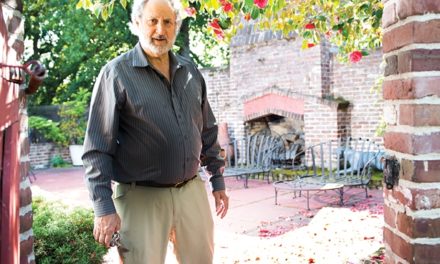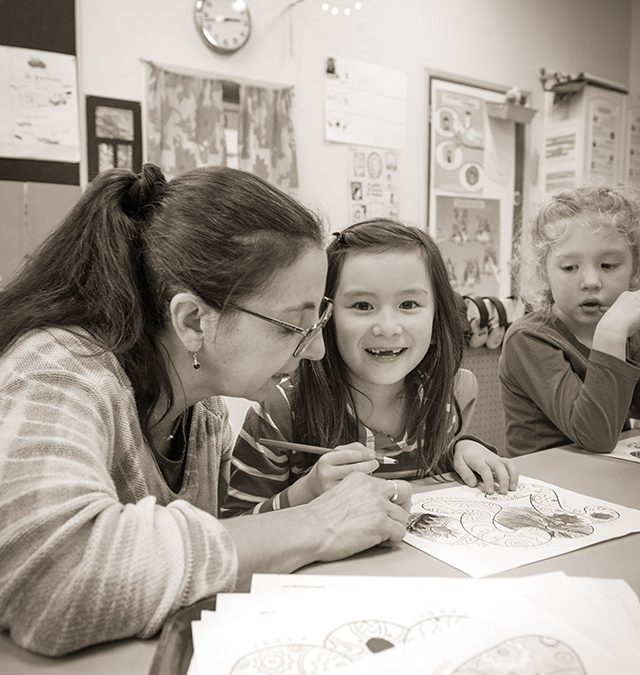Zach Reidman, left, New Roots program director, speaks with a farmer.
Refugee farmers learn and teach agricultural practices in a community setting.
Mustard greens—a lot of mustard greens—are required to make gundruk, the national dish of Nepal. Chhali Mainali, who spent 18 years with her family in the cramped quarters of a Nepali refugee camp, gathers armfuls of the green and purple leaves from a compact, lush garden at Laney College. In 2009, she and her family moved to Oakland with help from the International Rescue Committee. Thanks to the IRC’s New Roots program, gundruk’s spicy, fermented leaves will not only provide a satisfying ingredient of home cooking for the Mainalis, but will allow this family of farmers to lay down their own new roots in urban Oakland.
Tended by newly resettled refugees, IRC’s New Roots gardens have sprouted up in 14 cities, from New York City to Miami, Dallas to Seattle. Oakland’s garden was established in April 2013 to bolster its burgeoning urban-agricultural movement. Laney College donated a plot in its garden to create a community partnership and allow students to observe a range of agricultural techniques practiced by farmers from around the world. The IRC is an international humanitarian aid organization whose U.S. programs focus on refugee resettlement. A dozen refugees from Bhutan, Burma, and Cambodia—who were farmers in their home countries—water, weed, and cultivate the crops at the Laney College garden every Friday afternoon. Besides mustard greens, the prolific, bio-intensive, fifth-of-an acre produces corn, jalapeños, tomatoes, amaranth, radishes, onions, cucumbers, cilantro, kale, and other greens. A bountiful yield allows participants to take home a bagful of produce every week; any extra is shared with Laney College Bistro or sold to Phat Beets CSA, the local food justice collective providing affordable access to fresh produce for marginalized Oakland residents.
Founded in 1933, as a suggestion from Albert Einstein to help Germans fleeing Hitler, the IRC has been helping refugees from more than 40 countries as well as survivors of droughts, tsunamis, and typhoons ever since, and has resettled thousands in the United States, providing basic necessities and tools for self-reliance.
With classes in ESL and in micro-producing, the IRC has a long-term goal of training Oakland’s new citizens to be self-sufficient and eventually prepared to sell their produce at local farmers markets.
Chandra Mainali, 18, was born in the Nepali refugee camp and moved to Oakland with his parents and siblings when he was 14. The first-year student at Laney College has picked up English quickly and often serves as his mother’s interpreter. “When I arrived, I didn’t even know how to say ‘hi’ to someone,” he admits with a shy smile. Chandra’s goal is to become a pharmacist, a job choice his parents support because it is a helping profession that avoids the hard physical labor of farming.
His father, Kapil, recalls growing up in the hills of Bhutan, where each home produced enough food to feed a large family—Kapil was one of nine children. The extra was shared with neighbors or taken to market. Kapil and his father used to walk for more than a day up and down rugged mountainsides, toting heavy bags of apples or oranges on their backs to sell at the market.
On a serene, sunny afternoon at IRC’s lush garden on the edge of the Laney College campus, a pelican wings its way across the nearby estuary as a dozen farmers bend over clumps of swaying leaves, weeding, or sit cross-legged cleaning bunches of plump red radishes. They chat and laugh. The only incongruous part of this scene is the many pairs of small scissors the farmers use to delicately snip the arugula and other micro-greens destined for the Laney College Bistro. This is definitely not the twist-and-pull technique they are used to. But it’s only one of a myriad of elements of American culture they are faced with.
“On their arrival in U.S. cities, refugees may find it difficult to access fresh, locally grown produce. They are usually surrounded by convenience stores but often a bus-ride away from healthy, culturally appropriate foods,” says Zack Reidman, IRC’s New Roots program coordinator in Oakland.
“Through connecting refugees with land to grow their own food, the New Roots program not only improves family and neighborhood food security, but provides opportunities for cross-cultural knowledge sharing and community integration. Some New Roots growers have been farming for more than 50 years, are experts at producing great amounts of food in limited spaces, and have a lot to share with the Oakland community. This program allows them to have a food-secure resettlement, continue their cultural food traditions, and become self-sufficient and independent,” Reidman says.
As Chhali Mainali gingerly plucks some leaves known here as “stinging nettles,” she explains, through her son Chandra, that they are eaten for medicinal as well as nutritive properties. “Boil them with garlic, salt, and ginger for 25 minutes and eat with rice, like a curry,” she counsels. “It’s good for blood pressure.”
The Mainalis belong to a Nepali-speaking ethnic minority group, the Lhotsampa, who lived for many years in Southern Bhutan. In the 1980s, however, the King of Bhutan started a “one nation, one people” campaign and outlawed their Nepali language, traditional dress, and religion. They were forced to flee to a refugee camp in Nepal where they, and 80,000 other refugees, lived in tiny spaces. “They gave us some bamboo sticks and plastic to build our house,” Kapil says, “but when the rains came, the house blew down.”
The U.N.’s refugee agency, the United Nations High Commissioner for Refugees, provided minimal food rations: rice, beans, oil. and a few vegetables. The Mainalis tried to grow a few extra vegetables on a tiny plot of land, but hungry fellow refugees would often steal these in the middle of the night. One could buy extra fruit and vegetables, but only at outrageous prices.
Resourceful Kapil found jobs in India as a security guard and medical assistant and would bring the family some extra money on his rare visits home. Now they are together again, and Kapil appreciates only working eight hours a day at a local thrift store, instead of the 14-hour days he was used to in India.
Chhali Mainali is clearly at ease in IRC’s verdant, garden oasis. “I like everyone working together and sharing,” she says as she wipes the dirt from a bunch of radishes. Red radishes are new to Chhali, who is used to the long white daikon variety. But at home, she will make a spicy pickled red radish condiment using the fermented mustard greens, peppers, and onions.
In her bright pink skirt, green necklace, and sparkly bhindi, she explains how to prepare the mustard greens into gundruk. After picking, she lets the leaves dry in the sun for a day, and then packs them with hot water in large jars and lets them sit for 15 days until a pungent aroma is released. They can be eaten right away or dried again to use later to flavor curry, soups, and stews. Chhali often cooks the gundruk in oil with onions, vegetables, and her own spice mixture.
Refugees from various countries also learn from each other in IRC’s New Roots gardens. Chandra describes how he noticed that the Burmese, Bhutanese, and Nepalis each sow their corn according to a different pattern, either carefully dropping seeds into linear furrows close together or further apart or just scattering them onto the soil. “But,” he says, “they will all grow in Oakland.”
For more information on the work of International Rescue Committee, visit www.Rescue.org.
This article appears in the March 2014 issue of Oakland Magazine
Did you like what you read here? Subscribe to Oakland Magazine »
















